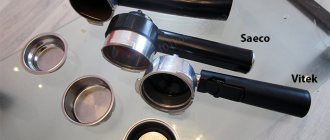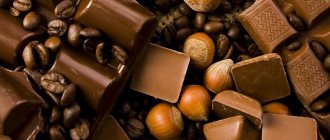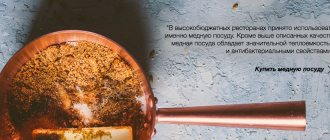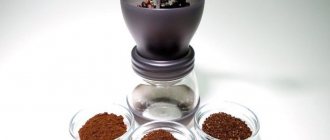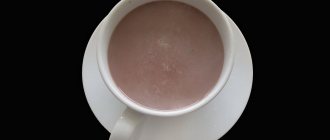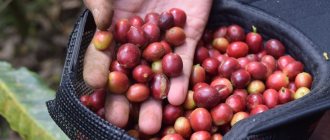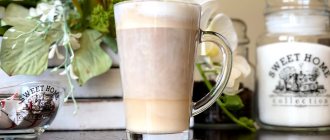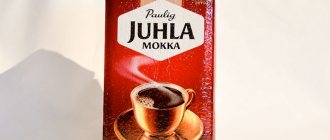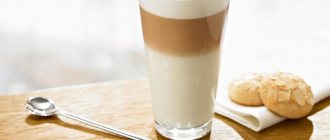Coffee sets are more often bought as a gift than for oneself, but this does not simplify the problem of choice and the need to study the assortment.
Sets of utensils for serving coffee are divided according to configuration, cup sizes, material of manufacture, design style and decor. Lovers of coffee ceremonies rarely make do with one set, since different methods of preparation require different utensils. This manual, with an overview of models and practical recommendations, will help you make a purchase without making mistakes.
In this publication:
Types of services by configuration and purpose
Coffee cutlery sets come in universal and narrow-purpose varieties. The former can be used for different types of coffee, while the latter may not be suitable for some recipes.
Classic coffee service
Standard coffee cups with a volume of 50 to 150 ml are suitable for coffee prepared in a coffee pot, coffee machine, electric coffee maker, French press. The volume depends on your preferred strength and your habit of adding milk and cream.
Traditionally, a coffee service for six people includes :
- cups and saucers, 6 pieces each;
- coffee pot;
- milkman (or creamer);
- sugar bowl
Often the set also includes other serving items:
- dessert plates – 6 pieces;
- pie dish or cake pan;
- flat plate for cakes, sandwiches, buns;
- coffee spoons.
The sizes of the cups and the additional items included depend on the purpose of the service. For example, the set for oriental coffee differs from the set intended for cappuccino or Americano.
This point is important to consider when choosing dishes as a gift. Modern manufacturers have long moved away from limited configurations, trying to satisfy the demand of all consumers.
Oriental coffee sets
The main items of a coffee service for Turkish coffee are still the same: cups and saucers. The cup size in this case does not exceed 60 ml . The shape resembles a small cylinder or round mug. We talked in detail about Turkish coffee cups, read here.
Traditionally, coffee sets in the East are made from fine porcelain, richly decorated, painted with gold and decorated with stucco. You can also choose cheaper sets made of ceramics or earthenware.
It is not always possible to find cake dishes and milk jugs in such a service. Sugar bowls are most often included, but not for loose sugar, but for lump sugar. But cups are often sold simply in sets of 2, 6 or 12 pieces.
This configuration is due to the fact that Turkish coffee is brewed in a Turk, therefore, there is an extra coffee pot here. Sugar is usually added at the cooking stage. And they serve a lot of sweets, one dish is still not enough.
But there are sets that include Turks for making oriental coffee. If the Turk is copper or brass, the cups are complemented with the same cup holders, and sometimes with lids. If ceramics are used as a basis, then all items are decorated in the same style. In some cases, the sets include cold water glasses and trays.
Espresso service
We have already described in detail what an espresso cup should be like here. The main distinguishing feature is the egg-shaped depression at the bottom , necessary for preserving the creamy foam. The second important point is the thickened body, which retains heat well.
Cup volume is 40-60 ml for classic espresso or up to 80 ml if you plan to add milk or water (Americano). True connoisseurs drink espresso only from white dishes.
Coffee pots are not included in the espresso set, as there is no need for them. This coffee is prepared in a coffee machine and poured into a cup once. Milk jugs, sugar bowls, spoons and dessert plates may be included.
Sets for cappuccino and other coffee drinks
This segment has a large selection of coffee cups of different shapes, sizes and designs. There are not only classic round cups, but also stylish square cups. Saucers are also difficult to classify. They can be curly, with recesses, asymmetrical, with high sides.
First of all, it is better to focus on the size of the cup - the classic cappuccino volume is 120 ml. But today fluffier milk foam is in fashion, so you can choose 170 ml containers. If you plan to make other coffee cocktails, choose even more. For example, for a latte, a 300 ml mug will not be enough.
The ideal material is thick-walled ceramics or glass ceramics. The classic color is pure white, which does not interfere with enjoying the beauty of coffee.
Sets with coffee glasses
Coffee utensils are not only classic cups, but also original glasses. A new trend appeared thanks to the invention of heat-resistant glass . Puff coffee drinks and espresso with foam are served in transparent dishes. Just do not confuse coffee cups with armuds - oriental teaware.
Small espresso coffee glasses have an egg-shaped bottom and slightly flared sides. Volume – 30-50 ml. In a transparent container, the foam of the “cream” is clearly visible. Sold in sets of 6 pieces without saucers or with saucers.
Tall glasses are designed for lattes and other cocktails. Their volume is 300-450 ml. The most interesting glasses are those with double walls. They are not only unusual in serving, but also practical:
- don't burn your hands;
- keep the drink hot longer;
- do not leave wet spots on the table and do not damage the furniture.
Irish coffee glasses are equipped with handles and legs. As a rule, they are sold without additional items.
Buffet table setting
When setting a buffet table, it is very important to ensure that the ends of the tablecloth hang at the same distance from the floor (5-10cm) on all sides. All corners of the tablecloth are turned inward from the end, the ends are fastened at right angles to the sides. The buffet table is served in two ways: one-sided and two-sided. The first option is used most often for guests of honor or banquet organizers, since the table is set on only one side. In this case, the table is placed at right angles to the main table at a distance of 1-1.5 m, or they are turned with one side towards the wall. Setting a table on both sides is called double-sided. The buffet table, covered with a tablecloth, is first served with glass (crystal): wine glasses, shot glasses, vodka, Lafite and Rhine wine glasses. Most often, some of the glasses and glasses are located on utility tables and, if necessary, are displayed for guests. It is most advantageous to set the table on both sides. In this case, there are several options for the arrangement of crystal and glass: in two rows, herringbone, groups and snake.
The buffet table is served mainly with appetizers and dessert plates. The number of plates for a banquet is determined at the rate of 1-2 pieces. snack bars, 2 pcs. desserts for each guest. Snack plates are placed on both sides along the table in stacks of 6-10 pieces. at a distance of 2cm from the edge of the table. Stacks of plates are located at a distance of 1.5-2 m from the end of the table. Dessert plates in stacks of 3-4 pieces. located in front of the snack bars, closer to the right side, next to the glasses. When arranging appetizer and dessert plates, one must not forget that the monograms (emblems, brands) of the restaurant on the plate should be facing the guest.
Next, the buffet table is set with fruit and snack utensils. For each guest (person), the required number of cutlery is calculated: snack forks - 1-2 pcs.; snack knives - 1-2 pcs.; dessert knives (fruit) - 1-2 pcs. Serving a buffet table with snacks can be done in two ways:
Option 1: forks, according to the number of snack plates (6-8 pcs.), are placed on the edge (edge to the plate) to the left of each stack of plates, and snack knives (3-4 pcs.) are placed on the right side of the plates.
Option 2: snack forks should lie on the edge, to the right of the snack knives and point towards the plate. The first method of serving a banquet/buffet table is most often found in restaurants. The number of fruit cutlery is equal to the number of dessert plates (3-4 pcs.). The distance between the edge of the plates and the first knife and fork should be 1.5-2 cm. It is advisable to use open-type pepper shakers and salt shakers and place them on the table behind plates of bread. You must put a spice spoon in all pepper shakers and salt shakers and turn its handle to the right. Linen napkins, folded into quarters and then in half, are placed behind each stack of snack plates. An approximate scheme for setting a buffet table is described in “Appendix No. 5”.
Classic and modern materials
When choosing a coffee set, it is important to pay attention not only to the items in the composition, but also to the material of manufacture. More often than not, this factor plays a decisive role. Traditionally, tea and coffee tableware is made from materials of the ceramic group: porcelain, ceramics, earthenware.
Fine porcelain
Porcelain is the most expensive material, characterized by lightness, strength, and high heat-intensive properties. The best types of clay are used for production. Other raw materials are added for strength and beauty. The most valuable and durable bone china , which contains 50% bone meal.
The products are subjected to repeated firing, which makes them resistant to high temperatures. Porcelain coffee sets are richly painted, decorated with stucco, perforation, and figured elements. The most durable painting is underglaze; it is applied before glazing.
European porcelain is light and thin, translucent in the light. Chinese is thick, more like ceramics. Be careful when purchasing coffee sets from online stores.
Ceramics and its types
Ceramics is a thicker and even slightly rougher clay-based material. Ceramic dishes are thick and retain heat well. Ceramic products must be fired and covered with glaze. The glaze can be white, brown, colored. Painting and stucco are also used for decoration.
Ceramic coffee sets are presented in a very wide range. These include pure white sets for espresso, pottery sets with Turks for coffee in an oriental natural brown color scheme, and universal tea and coffee cups with saucers in bright colors.
Crockery
Earthenware coffee sets were popular in Soviet times, when porcelain was not available to ordinary citizens. Earthenware differs from porcelain in its porous structure . Because of this, a fine network of cracks appears on the products over time, and the dishes easily break even with minor impacts.
But high-quality earthenware of the latest generation is more durable due to modifying additives. The dishes are beautifully painted, decorated with colored glaze and voluminous decorative elements.
Glass ceramics - a new material
Glass-ceramics is a relatively new material that combines the strength of porcelain and the practicality of glass. Glass ceramic cookware can be washed in the dishwasher and placed in the microwave.
Glass ceramic sets are similar in appearance to ceramic ones. They are white and black, the surface is smooth or wavy. Ideal for every day. The most commonly found on sale are glass-ceramic cup sets for espresso and cappuccino. The white set can easily be added to the set of tableware you already have at home.
Creating the atmosphere of different countries
At an Italian restaurant
There are no strict rules for arranging dishes, so be guided by meal times or serving format. But here are a number of native Italian table setting features (complete).
Residents of Italy prefer light colors and a certain ease in design. But you can play on the colors of the Italian flag, for example, use a red tablecloth with green and white checkered patterns. Simple white porcelain plates and silver cutlery in vintage style will harmonize with it.
When serving in this country, food is often used: randomly place cherry tomatoes, spaghetti or other ingredients typical of Italian cuisine on the table. But make sure that they maintain their presentation.
Serving in an oriental restaurant
Eastern food traditions are very different from those to which we are accustomed in Russia. You will have to understand the purpose of bowls, cups, flat plates and chopsticks, and also learn how to correctly place them on the table surface. Some do not use a table at all: there are establishments with stands on legs and carpets and stylized pillows laid out around them.
The advantage of oriental table settings is that their main principles are asymmetry and freedom. Usually, when decorating, dishes with ethnic patterns are used, so the table in an oriental restaurant is rich in different tones. An excess of dishes in an oriental restaurant is associated with the desire for comfort, although for those unaccustomed to such an abundance of cutlery, the first serving will be a real test.
Setting a table in a French restaurant
To create a French atmosphere, familiar porcelain dishes are used. It is important to position it correctly. French-style serving involves plenty of cups, jugs, and layers: why not place a saucer on top of a cup and place another one on top?
Choose dishes and coverings of the same color or with unobtrusive floral patterns. The main color becomes milky white, but don't be afraid to add additional ones, for example, green and peach. Tables in a French restaurant are often decorated with plant branches or artificial boutonnieres, handmade napkins and old table lamps.
There are several rules for arranging cutlery. So, the French place their forks with the tines down, and place the plate with bread on the left. You can see a detailed serving template in the photo. Remember that the art of decorating a table in the style of a specific country is a matter in which even the little things are important.
Review of services for coffee ceremonies
We invite you to evaluate the beauty and functionality of several sets selected for us in online stores.
A typical representative of a timeless classic is a porcelain coffee service of 15 pieces for 6 people. Includes 6 cups and saucers, coffee pot, milk jug, sugar bowl. The highlight is the square shape. Manufacturer: Leander, Czech Republic, “Bianca” series with a characteristic silver stripe. In the same series, the manufacturer produces other tableware.
The “Nostalgia” Turkish coffee set includes 4 0.2 l cups with saucers. The volume of the cezve is 0.7 l. Material – glazed ceramics.
Rocaille coffee service in Rococo style for 6 persons. The set additionally includes 6 dessert plates. Material: hard porcelain. Manufacturer: Germany, KPM Berlin.
The Chinelli coffee set is suitable for lovers of true luxury. The set includes white ceramic cups, brass saucers and cup holders, steel coffee spoons, and a brass sugar bowl. Sold in a beautiful gift box.
Tea/coffee table setting
When setting such a table, they use a coffee or tea set. For each guest, plates are placed under the pastry or cake a few centimeters from the edge of the table. On the right side, at a slight angle from the plate, a cup (handle on the right, parallel to the edge of the table) with a saucer is placed. The teaspoon is placed on the saucer behind the cup with the handle facing to the right. The cake fork or spoon should be to the right of the plate. If sandwiches, snack cakes, and savory pies are served during a coffee feast, then there is also a dessert plate for each guest, a fork for snacks is placed to the left of it, a fork for the cake to the right, and a knife for snacks behind it. The sugar bowl should have a spoon or tweezers for sugar if it is in lumps. If milk or cream is served with tea, they are poured into a milk jug, which is placed on a small plate to protect the tablecloth from dripping. Sugar and cream are always placed in the center of the table.
Setting a tea/coffee table is different in that the tea table should be colorful, as its appearance creates a joyful mood. Each guest is given a linen napkin that matches the tablecloth and is placed on their knees. Any element of decor, from the tablecloth to the central composition, can make the table original. Sometimes the table is covered with a small fabric runner to match the tablecloth, which is placed in the middle of the table. Since tea drinking involves a large number of treats, a pyramidal vase, which can serve as the central composition of the table, will be an indispensable item.
Sources used:
- https://gurman-bel.ru/kofeynyiy-stol/
- https://sgastronomy.ru/pereryv-tonkosti-kofeynoy-servirovk/
- https://studbooks.net/1921705/tovarovedenie/servirovka_furshetnogo_stola
How to choose a coffee set for the office
When choosing a coffee service for the office, focus on the specifics of the company's work. In most cases, the same rule applies as for catering - universal white cups with a smooth surface . Volume – 150-170 ml, to serve not only coffee, but also tea.
Simple dishes without decoration are easier to care for. And the traditional white color does not leave a chance to wash the cups poorly - any flaws are visible. Guests will be sure that they were served coffee in clean containers. If you want originality, choose stylish black sets.
As for materials, durable glass ceramics are ideal for frequent use. If necessary, such a mug can be placed in the microwave. Clear glass is not the best choice; it is difficult to clean, and stains remain on the surface if not dried properly.
You can buy a coffee set in online stores or in regular retail chains. The prices are affordable, the choice is huge, there is something to please yourself and your loved ones.
General Tips
- Be sure to have a salt and pepper shaker on the table. If a lot of guests are expected, distribute 5-7 sets around the table;
- If you cover the table with a tablecloth, make sure that the distance between its edge and the floor exceeds 20 centimeters. Otherwise, visitors risk tripping over the fabric. Choose a tablecloth made of a material that does not slip and does not make unpleasant sounds when rubbed: products made from moleton are suitable. If it is not possible to choose a high-quality tablecloth, use a thick tablecloth;
- Strictly follow the sequence of serving dishes. No force majeure will justify violating this rule;
- Make sure that there are no stains on the dishes and cutlery. To do this, check each plate or other container before serving;
- Remember that serving is not only about the elements that are located on the table. There are some rules for waiters. A restaurant worker should have a clean, ironed handbrake hanging on his hand. This towel protects against burns when carrying high-temperature foods. It is permissible to polish cutlery and dishes with a handbrake, but do not wipe off food residues from the table with a towel and do not wipe your hands with a towel;
- If there is not enough space on the table, you can use some tricks when installing dishes. For example, it is permissible to display wine glasses not in a line, but in a triangle. The main thing is that the glasses are in the correct order, if you look from the nearest corner and move clockwise;
- At special events outside the home, the use of placemats is strictly prohibited. It will look like you want to rid yourself of unwanted laundry when the customers leave;
- Don't forget about table decoration. A flower arrangement in a traditional restaurant should not exceed 30 centimeters in height, and should also be in harmony with the color scheme of the tablecloth. During dinner, decorate the surface with tall candles or low counterparts with a candlestick. But you can only light them for dinner, otherwise it will be considered bad manners. Yes, there are many rules for serving in a restaurant. But those who can master them will be able not only to properly set up a table for guests, but also to observe etiquette during a visit to a premium restaurant.
Festive menu for 15 people
Content
When served, the coffee is in the cezve. The guest is invited to bring the coffee to the correct state (whip the foam and let the coffee suspension settle) and pour it into the filjan. There is one and a half to two fields of coffee in the cezve.
Beat kaymak
Coffee is served with two or three lumps of sugar and Turkish delight, which is often carefully placed on a toothpick. Sugar is not dissolved, but eaten as a bite.
A new fad has led to the fact that at the dance there may be a package of cream, or even heated milk. According to tradition, milk is not added to Bosnian coffee. But foreign tourists, not knowing about it, ask for milk, so “kahfejia” come to meet them (kahfejia is a coffee master, barrista).
Deviation from the rules
There is coffee in one cezve, boiling water in the other
Forgotten traditions
One day (in a rather pretentious place) they brought me a device with two cezves.
One contained coffee, the other boiled water. To my surprise, the waiter explained: water is needed so that the guest can determine the strength of his coffee himself. Very prudent, but extremely rare. In another place (and not at all pretentious), coffee was served in a jug (ibrika) with a lid. Previously, I had only seen these in museums.
Previously, cezves also had lids: they drank coffee for hours, and it should not have cooled down. For this purpose, coffee was kept on the grill.
Serving coffee at Chabrina kafana


